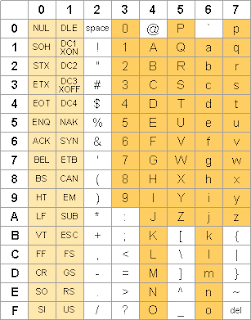Data Representation
Arithmetic & Logic Unit
- Does the calculations
- Everything else in the computer is there to service this unit
- Handles integers
- May handle floating point (real) numbers
Data types
- Represented in binary-coded form
- Only have 0 & 1 to represent everything
- Can be classified to these categories:
1. Numbers used in arithmetic computation
2. Letters of the alphabet used in data processing
3. Other discrete symbols used for specific purpose
Alphanumeric Representation
An alphanumeric character set is a set of elements that includes the 10 decimal digits, the 26 letters of the alphabet and a number of special character such as $, +, and =.
The standard alphanumeric binary code: ASCII (American Standard Code for Information Interchange) uses seven bits to code 128 characters.
Diagram 1: ACSII Code
Alphanumeric Representation
- Codes must be in binary because registers can only hold binary information.
- BCD (Binary Coded Decimal) represents each individual digit of a decimal number as a group of binary bits; the other formats would convert an entire decimal value to its equivalent binary value. *In the 8421 Binary Coded Decimal (BCD) representation each decimal digit is converted to its 4-bit pure binary equivalent.
Example Decimal to Binary Coded Decimal (BCD)
Number Bases
Different Bases
Decimal --------- (base 10)
Binary ---------- (base 2)
Octal ----------- (base 8)
Hexadecimal ---- (base 16)
The Decimal Number Systems
- The decimal system uses 10 as a base, and the 10 digits available are 0, 1, 2, 3, 4, 5, 6, 7, 8, 9.
- Depending on its position in the whole number.
For example, the decimal number 9348 represents:
For example, the decimal number 0.258 represents:
For example, the decimal number 7534.448 represents:
The Binary Number Systems
The binary system uses 2 as its base with the digits 0 and 1.
Let’s look at 110100 as an example of a binary number.
Example 1001.101 of a binary number.
In summary, what you need to be able to understand is that the value that is represented by a digit depends on the digit’s position within the number and the base of the numeric system used. With every move of a digit to the right the value represented decrease by a power of the base.
Decimal to Binary Conversion
Integer and fractional parts are handled separately.
Example 19.6875 (base 10) to Binary.
The Octal Number System
- Base-8 number system.
- In octal numerals each place is a power with base 8.
- Uses the digits 0,1,2,3,4,5,6,7.
Example Octal to Decimal: 122 (base 8)
Example Decimal to Octal: 1028 (base 10)
Octal to/from Binary
The binary numbers should be grouped into 3 numbers each as 2 (power 3) = 8.
Example Binary to Octal: 1111101.1001 (base 2)
Example Octal to Binary: 56.3 (base 8)
The Hexadecimal Number System
- 16 Hexadecimal Digits: 0 – 9, A – F
- More convenient to use than binary numbers
- Binary digits are grouped into sets of four bits.
Binary, Decimal, and Hexadecimal Equivalents
Example Binary to Hexadecimal: 1110 1011 0001 0110 1010 0111 1001 0100
Hexadecimal to Decimal
Multiply each digit by its corresponding power of 16
Example Hexadecimal to Decimal: 1234 (base 16)
Decimal to Hexadecimal
- Repeatedly divide the decimal integer by 16
- Each remainder is a hex digit in the translated value
Example:
If you don't understand what I was explain. Watch this video:







































